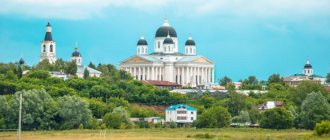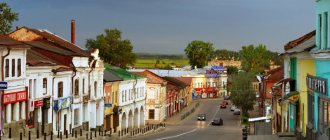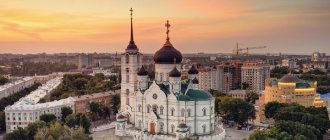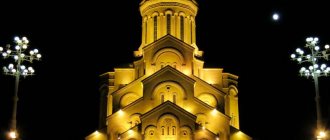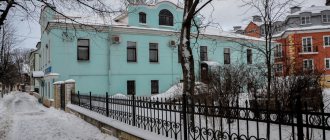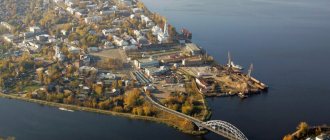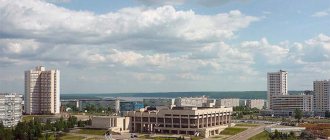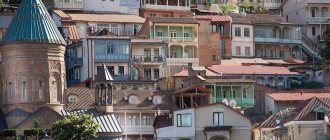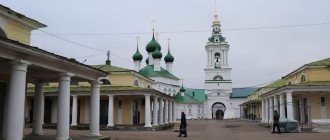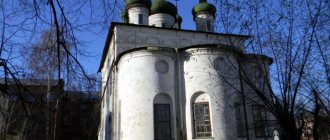Elabuga is an ancient and beautiful city on the banks of the Kama River, which flows in Tatarstan. Here you can find many historical attractions. Tourists flock here to appreciate the unusual architecture of the buildings and see with their own eyes the natural beauty of the flowing river.
There are few cities where you can find so many historical buildings. From military fortifications to church buildings, there is a lot to see here.
The city is located 200 km away. from the capital of Tatarstan, just at the confluence of the Toyma River and the Kama River, where a wide floodplain is formed. This is the center of the Elabuga region, forming an urban settlement and entering the Nizhne-Kama (Naberezhnye Chelny) agglomeration.
You can sign up for an excursion in one of the large Russian cities located in relative proximity to Yelabuga
From Yoshkar-Ola
From Kazan
From Cheboksary
The area of the city is slightly more than 40 km2, and the population exceeds 70 thousand people, so it cannot be called a very large urban center. At the same time, the good socio-economic development of this place is due to its favorable location, right at the intersection of important trade and economic routes. Thanks to this, historically many merchants, representatives of the clergy, artisans and other people came to Elabuga and contributed to the development of the city.
History of the development of Yelabuga
The year of foundation of the city is considered to be 1780, but in fact people lived in this place for over 100 years, since already in 1010 a large urban settlement was formed here, which is confirmed by a number of written sources. Despite this, scientists have not yet been able to establish a more precise date of settlement, however, there is information that the first settlements in this area could have been as early as the 5th century BC. This is confirmed by excavations of the Ananyinsky burial ground, where scientists were able to discover several artifacts.
In the first half of the 17th century, the first Christian monastery was built here - Trinity, which marked the beginning of a new era in the formation of the city as the spiritual center of the region. Just on the site of the modern city at the end of the 16th century there was a settlement of Trekhsvyatskoye, which numbered several thousand people. With the beginning of active construction of churches, the settlement gradually began to transform and in 1780 this place officially received the status of a county town at the behest of Empress Catherine II.
A very significant road ran here from Volga Bulgaria to the northern part of Russia, right up to the Arctic Ocean, so there were always many merchants in the city. Thanks to the skill of the architects, interesting stone buildings from the 17th-19th centuries have still been preserved here, which are of great interest to modern tourists. By the beginning of the 19th century, the city had turned into a large industrial zone, and 100 years later, in the 20th century, Elabuga became a leading city in the production of vehicles and spare parts. Today it is the largest industrial city, where several plants and factories operate, the production of agricultural machinery is established, and the oil industry is well developed.
Description and history of Yelabuga
This is a small town near which the Ananyinsky burial ground was discovered. Its age exceeds 2.5 thousand years. This is the first open burial ground that revealed to the world a new archaeological culture - Ananyinskaya.
The history of Elabuga begins with the settlements of the Volga Bulgars in these places. This was in chapter X - beginning. XI century In the 16th century monks founded a monastery here, and later built the Trinity Monastery, surrounded on all sides by the village of Trekhsvyatsky. In 1780, the village received the status of a county town as a reward from Catherine the Great.
Gradually, Elabuga became a center of merchants, where 12 millionaires lived, and became one of the ten Russian cities with running water and electricity.
The bulk of the townspeople worked in factories producing:
- candles;
- bells;
- cast iron;
- beer;
- honey;
- flour;
- gingerbread;
- lard
The city has great cultural and historical significance, as it is associated with the names of famous people: poetess Marina Tsvetaeva, artist Ivan Shishkin, opera singer Azat Abbasov, cavalrywoman Nadezhda Durova, psychiatrist Vladimir Bekhterev and many others.
Elabuga, whose sights have a thousand-year history, ranks second in the country after the capital of Tatarstan in terms of the importance of historical and cultural heritage. Today about 74 thousand people live and work here.
Damn town
If you don’t know where to go in Elabuga to immerse yourself in the spirit of antiquity, we recommend starting with the Devil’s Settlement.
Story
At this site there was a large fortified settlement, which was created several thousand years ago. In the 11th century, the Bulgar feudal lord built a small fortress on the site of an ancient fortification. In 1236, after the invasion of the Tatar-Mongols, Volga Bulgaria fell and was included in the Golden Horde. The settlement was completely plundered and abandoned.
A new page in history began after Ivan the Terrible conquered the Kazan Khanate. In 1614, monk Ion Zeleny founded a monastery on the site of the former settlement. The Trinity Monastery existed until 1764, gradually expanding its territory. Not far from the hill a settlement was formed, it was called Podmanastyrsky, later the name was changed to Podmonastyrka.
There was a small village near the settlement; in 1780, by decree of Empress Catherine II, the village was given the status of a district town, part of the Vyatka province. The city began to be called “Elabuga” from the ancient “Alabuga”, but in honor of Catherine it was decided to change the first letter in the name to “E”. A few years later, Podmonastyrka Posad became part of the city.
After the monastery was closed and the monks left the site, it fell into disrepair. The surviving buildings were dismantled by local residents for building materials. In 1834, there was a lone tower here, and in 1844 its wall collapsed, and only the northern part remained.
In 1867, the merchant I.V. Shishkin, the father of the famous painter, saw his son’s sketches, which were made in 1855. After what he saw, I.V. Shishkin decides to completely reconstruct the structure. With his funds, the collapsed part of the tower was restored and an iron roof was laid. In this form, the building existed until the times of the Soviet Union.
After the collapse of the USSR, large-scale studies of archaeological sites began to be carried out on the territory of Tatarstan. Historians have identified the site as the remains of a mosque. In the 2000s, reconstruction was carried out, and in 2007 the settlement was included in the list of sites under UNESCO protection.
What can you see
During your visit, you will be able to see the ancient tower and walk around the settlement itself. From here you can see a picturesque view of the floodplain of the Kama River and the historical center of Yelabuga.
Interesting legends
Many tourists are interested in why the area is called that. According to one legend, during pagan times there lived a serpent-oracle, or simply the devil, here. He was famous for his predictions; people from all over the area came to him to find out their fate. He took human lives as payment. One day the serpent disappeared, and soon the Bulgarian kingdom was destroyed.
Top 10 most interesting attractions
Elabuga attracts the attention of tourists with its numerous historical and architectural monuments and natural beauty. Here you can visit houses where famous people lived, walk along the Alley of Lovers, visit museums, go to cathedrals and admire their beauty.
Elabuga settlement
Lovers of antiquity visiting Elabuga strive to see the famous archaeological complex, called the Old Town by locals. This place was once inhabited by the Volga Bulgars. Several legends have been written about it, one of which gave it another name - Devil's Settlement.
Of the entire settlement, only a stone tower remained. In the middle of the 19th century. it was partially destroyed. The arched opening above which the window was located remained intact. Thanks to I.V. Shishkin (the head of the city), the tower was restored a few years later.
Now this restored structure is covered with a new roof, has an entrance gate, and is surrounded by a small fence. Along the slope on which it is installed, there are walking paths for tourists and benches.
This architectural monument is included in the UNESCO World Heritage List.
Excursions are organized for visitors to the tower, during which the guide tells several beautiful legends about this ancient settlement. It also offers panoramic views of the city.
Ananyinsky burial ground
Another ancient monument is the Ananyinsky burial ground. It was opened in 1868 near the city. This happened by accident, when the waters of a river that overflowed in the spring washed away a four-meter hill, and human remains and objects of ancient life were found in the deep layers of the soil.
Numerous items found here have been added to the collections of several city museums and exhibitions. Some of them were sent abroad.
It was this historical find that gave birth to a new term - Ananyinskaya culture (era). When talking about this culture, experts mean the history of the development of the Middle Volga region from the end of the 9th to the 3rd centuries. BC. This place became the epicenter of excavations, the boundaries of which expanded by several kilometers.
At a distance of 11 km from the city, many artifacts (1,500 objects) were found that testify to the peculiarities of the cultural life of the ancient inhabitants - log dwellings, burial grounds, remains of fortifications, shrines. At the foot of the ancient hill, 2 stone boats were discovered, which served as the burial place of the rulers. There were also weapons and jewelry there.
Holy Key of Panteleimon the Healer
Numerous pilgrims often visit the spring, consecrated by the Orthodox Church, with natural water considered healing. He bears the name of Panteleimon the Healer.
The consecration of water occurs annually on the day of remembrance of this saint - August 9 - and on Epiphany. This natural monument is located near Elabuga and is protected by law. One of the famous natives of these places, the artist Ivan Shishkin, captured the source in his painting.
Anyone can draw holy water or bathe in the spring. There are swimming pools, stone paths, and benches and gazebos where you can relax.
Shishkinsky Ponds
One of the favorite vacation spots for residents and guests of Elabuga is Shishkinsky Ponds, named after their founder, the father of the famous artist. This is a recreation area in a picturesque place with numerous bodies of water (ponds, springs, fountains). In this park you can relax, sitting on benches or in a gazebo, walk along paved paths and openwork bridges, and admire the flower beds.
This place hosts city holiday events, fairs, exhibitions and sales of handicrafts, and performances by artists.
The park area includes:
- Stakheev embankment;
- Ushakov Square;
- Shishkin nursery.
Spassky Cathedral
The embankment of the city in its historical part is decorated with the Spassky Cathedral, which is more than 200 years old. Its height is 57 m, and architecturally it is an example of Russian classicism.
People come to the temple not only to pray, but also to admire the beauty of the interior decoration. The paintings on the walls are the result of the work of famous masters of the brush - I. Bruni and V. Vereshchagin. Icons and church utensils are decorated with gold, silver and precious stones.
In 2007, the cathedral was restored. Now it has 12 bells, the ringing of which attracts numerous visitors. Every year a bell ringing festival takes place here, in which masters from all over Russia demonstrate their skills.
Alexandrovsky Park
Alexander Park is the oldest of all city parks.
In connection with the coronation of Alexander II in 1856, a garden was laid out on this site. It was created according to the rules of English landscape architecture. There are clearings, small lawns, connected by winding paths. Visitors can spend time here relaxing in the gazebos or on benches in the shade of the trees.
Previously, the center of the park was decorated with a theater building and various attractions for children, a dance area and a fountain. Gradually, the park territory fell into disrepair, and only in 2010 did the park experience a rebirth.
Now it is a landscaped recreation area with asphalt paths, benches, lanterns and a new fountain. Every year the Descendants' Ball is held here, which brings together the descendants of famous people of the city.
Museum of County Medicine
Many of Elabuga's sights are associated with the names of famous people. One of them is V. Bekhterev. An outstanding neuropathologist, psychologist, and academician was born in this city. The unique Museum of County Medicine, located in the building of the zemstvo hospital, was named in his honor.
The museum exhibits tell about the historical development of healthcare in Elabuga.
Tourists can see here what they were like:
- a doctor's office in a county town;
- pharmacy;
- department for the treatment of children;
- operating room;
- ward for the mentally ill;
- house of a healer.
Local history complex
When the city turned 1000 years old, a local history complex was opened in the center, which is an architectural monument of the 19th century. Previously, the merchant Nikolaev lived in this building, combining eclecticism with baroque style.
The complex consists of several museums: one of them tells about the history of Yelabuga, the other houses the Tavern theater, where visitors can be fed delicious and simple food. The interior items in the Tavern were selected with a sense of humor and love for Russian history.
The complex has interactive workshops. Coming here, everyone has the opportunity to make any household item with their own hands, using folk crafts.
Elabuga masters give master classes on:
- making pottery;
- wicker weaving;
- embroidery;
- macrame;
- wood paintings;
- making souvenirs.
Here you can also buy ready-made goods. Parents with preschool children often come here to take their first craft lessons. The complex includes an exhibition hall designed for holding exhibitions, lectures and various presentations.
Memorial Trinity Cemetery
This place is part of the necropolis, where ordinary townspeople and famous personalities are buried, whose lives are connected with the history of the city. This memorial complex contains part of the preserved ancient church, ancient monuments and crypts, each of which is of historical value.
In the central part of the complex there is a monument to Nadezhda Durova, a famous woman who received the title of hero of the Patriotic War of 1812. The monument is made of green granite and is under state protection.
The merchants-philanthropists Stakheevs, known throughout Russia for their commercial successes, charity, and also made a significant contribution to the development of the cultural life of the city, are buried here.
Don't miss the most popular article in the section: Metro Nizhny Novgorod. Diagram, map, description.
Memorial complex of Marina Tsvetaeva
Despite the fact that the famous poetess did not live in Elabuga for long, the townspeople honor her memory. She died here, having lived in evacuation for less than a month. Her grave is located on the edge of the Peter and Paul Cemetery.
Not far from the house where Tsvetaeva lived with her son, there is a memorial complex, which includes:
- house of memory;
- literary museum;
- the square named after the poetess;
- cafe;
- Silver Age library;
- Portomoynya Museum.
The square is decorated with a bronze bust of Tsvetaeva, and the cafe often hosts memorial evenings and literary readings.
Shishkinsky Ponds
One of the main attractions of Yelabuga is Shishkinsky ponds. The complex is located on the banks of the Toima River, surrounded by picturesque vegetation. It includes a landscaped, landscaped park, an embankment, a public garden, and a nursery.
Story
The area was founded by Ivan Vasilyevich Shishkin, the father of the famous landscape artist I. I. Shishkin. Ivan Vasilyevich was not only a wealthy merchant, but also held a high position and twice became the head of the city. He loved Elabuga and invested a lot of money and effort into the development of his beloved city. Ivan Vasilyevich was not just a sponsor of numerous archaeological excavations, but he himself took a direct part in them.
In the mid-30s of the 19th century, he organized a spacious recreation area for citizens and guests of the city.
During the Soviet Union, the park area was abandoned and fell into disrepair. The development and reconstruction of the park's territory began only in 2007, for the city's anniversary. After careful work, the reservoirs began to work again, walking areas and places for recreation were installed. In addition, a large number of flowers and vegetation were planted.
What to see and do
After exploring the cultural sights of Yelabuga, go to Shishkinsky Ponds. Here you can walk through picturesque places, enjoying clean air and nature. Benches, benches, and paths are provided for comfortable relaxation. Fountains and ponds provide coolness even on the hottest day.
The park administration monitors order and cleanliness. City holidays and various special events are regularly held here. In the evenings you can attend performances by creative groups and musical groups. One of the brightest events is the Spasskaya Fair, during which you can not only see folklore performances, but also buy arts and crafts products.
Architectural objects and monuments of Elabuga
Not far from the Yelabuga settlement stands a 15-ton monument to Ibrahim I ben Muhammad, the Bulgarian emir who founded this city. He represents a horseman, dressed in the armor of a warrior and sitting on a war horse. The warrior points to the city. Its height is 17 m.
The earthen rampart surrounding the monument is part of an ancient fortification. The figure of the horseman is visible from passing steamships and from any part of the city, since he is mounted on a massive stone-boulder. A restaurant and an observation deck were built not far from it.
An architectural monument and the pride of Yelabuga is the university building, built in 1903 (architect I. Charushin) at the insistence of G. F. Stakheeva, who decided in this way to perpetuate the memory of her late husband, the merchant V. G. Stakheev. The university is located in the historical center of the city.
Especially durable brick was used in the construction of this three-story symmetrical building. During the laying of the foundation, one gold coin was placed under each corner of the future building. The decoration of the central risalit is distinguished by the Byzantine style, and the semicircular arched windows located on the additional floors of all risalits create a feeling of special representativeness of the building.
The Jamig Cathedral Mosque is an example of Muslim architecture. The mosque is located on the highest elevation in the city, which allows it to be seen from all points of the city. Its minaret reaches a height of 57 m, and the chandelier on the ceiling weighs half a ton.
The architecture of the mosque is dominated by oriental traditions, and its interior is decorated with 27 carpets woven in the traditions of Tajikistan. The mosque has a hotel with a teahouse, a garage and a house where the abbot lives.
Pedagogical University building
The list of attractions of Elabuga includes the building of the Pedagogical University. The complex consists of three floors, with a dome installed at the very top. The story goes back to 1898, when philanthropist Glafira Stakheeva allocated a large sum of money for the construction of the university.
Interesting Facts
There is an interesting story connected with the architectural complex. During the laying of the foundation, gold coins were laid. According to legend, this was supposed to become protection and additional fortification. After all, gold has long been famous for its magical powers.
Historical monuments of Yelabuga
The main historical and archaeological monument of federal significance is the Devil's Settlement, located on the right bank of the Kama. Here, on an area of more than 4 hectares, there was an ancient settlement.
Now there is a historical and archaeological complex with the remains of an ancient 7-meter citadel, ramparts and ditches. This place became the starting point in the development of modern Yelabuga.
The Church of the Great Martyr Barbara is another historical monument of Elabuga. It was built in 1887 and is part of the Kazan-Bogoroditsky convent. For a long time it did not function, but since 1995 it was consecrated and resumed work. Tourists and ordinary believers can attend the services that take place here every day.
In Elabuga there is a bronze monument to an unusual woman - cavalrywoman N. Durova, a native of this city, who participated in the battles of Gutshadt, Friedland, etc. It is located near the Trinity Cemetery on Kazanskaya Street. N. Durova is depicted in full growth, with full combat ammunition, sitting on a horse and holding a weapon in her hand.
Temples of the city
- The Spassky Cathedral is the largest temple in Elabuga, built on the site of an ancient wooden church at the beginning of the 19th century, again with the active participation of the city's merchants. It is a structure more than 50 m high with five domes and a bell tower with 12 bells. The main relic of the temple is the icon of the Savior Not Made by Hands, which miraculously survived the destruction of the cathedral in the first half of the 20th century. The Alexander Nevsky Chapel was built near the cathedral.
- Church of the Intercession of the Blessed Virgin Mary from the 19th century , considered part of the memorial to M. I. Tsvetaeva. It was here that the poetess' funeral service was held. The church has preserved bells installed at the end of the 19th century.
- The Monastery of the Kazan Mother of God in its heyday (the beginning of the last century) was the largest monastic complex. In the 30s, its main buildings were destroyed. Active restoration work on the territory of the monastery began in 1995. Now the Church of the Kazan Icon of the Mother of God, the Church of St. Barbara, and the Chapel of John the Baptist have been restored.
- St. Nicholas Church on the Embankment was also built at the beginning of the 19th century. Over the period of its history, it has undergone several alterations, but both the church building itself and the painting of its interiors have been well preserved.
- In Yelabuga you can also see a mosque called Dzhamig, more than 50 meters high, with a rich interior and a magnificent glass chandelier weighing half a ton.
Interesting museums in Yelabuga
Near the Spassky Cathedral on the Embankment there is a museum of the famous artist, whose life and work were connected with Yelabuga, Ivan Shishkin. The Russian artist was born in this building and lived until 1852. Coming here, you can plunge into the atmosphere of that time, see the interior of the rooms, including the master’s office, and look at the paintings in the gallery.
On M. Pokrovskaya Street there is the house-museum of M. I. Tsvetaeva. She came here after evacuating from Moscow. The poetess lived in the old house of the blacksmith Brodelshchikov for only 11 days, but the townspeople still remember and honor her.
A visit to the museum leaves an indelible impression of touching the beautiful and the tragic. There are some personal belongings of Tsvetaeva, volumes of her poems that make up a small exhibition, and poems are read. The suicide notes of this great woman leave no one indifferent.
In Elabuga there is a unique Museum of County Medicine named after Academician V. Bekhterev, which is located in the premises of a former neurological hospital.
Of scientific value are the articles by V. Bekhterev, published by him during his lifetime, books on medicine, and instruments that doctors once used. A separate exhibition is dedicated to the life and work of the academician, occupying an entire hall of the museum. There is a monument to him in the courtyard.
Visitors can use the interactive room and try tea brewed from medicinal herbs, find out their blood pressure, height and weight.
Memorial complex of Marina Tsvetaeva
The life and tragic fate of Marina Tsvetaeva is closely connected with the city of Elabuga. The memorial complex consists of several objects. Each of them provides an opportunity to better understand the work and life path of the poetess.
- The Brodelshchikovs' house is a house of memory; the atmosphere that was during the poetess's life is completely recreated here.
- Square - in the city, an entire square is named after Marina Tsvetaeva; here is her monument in the form of a bronze bust mounted on a granite pedestal.
- Literary Museum - was opened in 2004, the exhibition occupied four halls. During the excursion you can see the poetess’s personal belongings, purchased from her relatives for the museum collection. In addition, manuscripts, documents, letters and books of the writer are presented here.
In addition, the memorial complex includes a library and the Silver Age cafe, which often hosts literary evenings and cultural events.
Temples and cathedrals of Elabuga
Elabuga, whose attractions will satisfy any interest, is an example of an organic combination of Christian and Muslim traditions. There are temples and monasteries here where you can learn about the characteristics of the two religions.
The Kazan-Bogoroditsky convent in Yelabuga, judging by various sources, was built in 1850 or 1868. By the end of the 19th century. More than 300 nuns lived and worked there. They made candles, painted, sewed, and worked in the garden and on the farm.
The monastery was closed at the beginning of the twentieth century, and during the Great Patriotic War and after its end, prisoners of war lived here, and later there was a library and training rooms for the NKVD.
The second life of the monastery began in 1995 after restoration. Nowadays, divine services are held here at 8 a.m. and 4 p.m. every day. In the center of the city is located the Church of St. Nicholas the Wonderworker, no less attractive for tourists. It owes its appearance to the well-known merchant and philanthropist A. Stakheev in the city.
The uniqueness of the temple lies in some architectural features, not always traditional for religious buildings of that time:
- lack of apse;
- rectangular shape of the altar;
- one dome.
The temple building was built in the style of Russian classicism. The interior decoration was done by famous masters - artists V. Vereshchagin and P. Pervunin.
Representatives of the Muslim faith can visit the highest mosque, Jamig, which is an example of Muslim culture. The two-color facade, rich carpets and beautiful decorations make the temple unique and majestic. In addition, in Elabuga there are the Nur and Al-Qadir mosques, Ikhlas and Shatlyk are under construction.
How to get there
You can get to Yelabuga by various transport:
- By car. You can get from the capital of Russia to Yelabuga by car along the M7 highway. The distance between it and Moscow is 1043 kilometers - the whole journey will take approximately 15 hours. You can get to the city along the same route from Kazan (208 km, 3 hours), Ufa (322 km, 3.5 hours) and Nizhny Novgorod (500 km, 9 hours). Regional routes from Izhevsk and Naberezhnye Chelny also lead to the destination.
- By train. There is no railway station in Elabuga itself, but there is one in Naberezhnye Chelny, from where you can get to your destination by bus. But this method is not the most convenient, since there are few trains to Naberezhnye Chelny - only from Moscow, Krasnodar, Adler, Saratov, Perm and Izhevsk. The best option is to take the train to Kazan, and from there get to the town itself.
- By bus. Direct flights to Yelabuga exist only from Kaznya, Ufa, Cheboksary and Perm, as well as the nearest cities of Tatarstan. To get to Yelabuga by bus from other settlements, it is better to first come to Kazan, and from there go to the town itself. The road from Kazan to Yelabuga will take on average three hours, and a ticket will cost 450–550 rubles.
- By plane. There is no international airport in the provincial town of Elabuga. There is no air transport here at all, and the nearest air terminal (Begishevo) is located 44 km away - in Nizhnekamsk. You can get here from Moscow, St. Petersburg, Sochi, Anapa, Nizhny Novgorod, Simferopol and Turkish Antalya. However, it is not possible to get directly from here to Yelabuga. First, you will need to get to Nizhnekamsk or Naberezhnye Chelny, the distance to each of which is about 25 kilometers, and only then take a bus to your destination. You can also fly to Kazan by plane, where flights operate more frequently and from a larger number of cities, and then go to the Eastern Station and transfer to a bus to Yelabuga.
- Water. In the warm season (from May to September), a romantic and colorful way to come to Yelabuga appears - by water. River buses departing from Naberezhnye Chelny and Nizhnekamsk arrive in the city. Ticket prices from Nizhnekamsk are 55 rubles, from Naberezhnye Chelny - 65 rubles. And from Kazan and Chistopol to Elabuga, high-speed ships “Meteor” or “Raketa” sail.
Photo gallery: how to get to the city
You can get to Yelabuga along the M7 highway.
The Elabuga bus station building is new, it looks like a glass sailboat, and there is a hotel on the third floor
You can get to Yelabuga from Kazan by Meteor, but only in the warm season
Parks and natural attractions of Elabuga
Elabuga, whose attractions amaze with their diversity, provides citizens and tourists with numerous places for recreation and walks. One of them is the unique Lantern Park, a kind of gift from neighboring Bugulma. Here you can see a variety of street lamps and relax sitting on benches.
Not far from the Devil's Settlement there is a park founded in honor of the 1000th anniversary of Yelabuga. People come here to admire the apple blossoms in the spring and enjoy delicious fruits in the fall. There are many flower beds and an observation deck.
Lovers of folk crafts love to visit the Shishkinsky Ponds Park, where an annual exhibition of works by craftsmen demonstrates their talent in pottery, embroidery, making souvenirs from various materials, sewing, and carpet weaving.
Where to go with children in Elabuga
- To the Elabuga settlement - examine the tower and ruins of the fortress , the monument to the emir , admire the panorama of the city from the observation deck .
- To the historical museum and living corner of the local history complex .
- To the city embankment , to Shishkinsky ponds .
- For a walk in Alexander Park .
I have almost never met towns like Yelabuga - with a population of only 75,000 people - that were so rich historically and spiritually. Plus impressions of the most beautiful surroundings. I want to come here again and again. Did you like it in Yelabuga?
Modern objects interesting to visit
Elabuga is a city where history and culture are revered. In 2015, the Memory Museum was opened here, which presents exhibits telling about the life of the city during the Great Patriotic War and the contribution of local residents to the victory over fascism.
The museum contains documents of those times, weapons, photographic materials, and belongings of soldiers. Here, in a recreated dugout, you can take a photo while trying on a soldier’s costume.
For art lovers there is an Exhibition Hall in Yelabuga. This building once belonged to the merchant A. Nikolaev, now paintings by contemporary artists are exhibited here, meetings with interesting people, music evenings, and conferences are organized. For those interested, master classes are held on teaching the art of drawing and making arts and crafts.
In 2016, the city recreated Pioneer Park on a once abandoned area. Couples with children come here to play on the playground. For lovers of active games, quests are held here weekly.
The city has its own Big Ben. This is a clock that is located in the central part of Yelabuga and is made after the example of the famous London tower. From below, this structure is made of red marble, merging into a two-tone white and green flooring. There are 4 dials, “looking” at the four cardinal directions. Visitors can stay in hotels and hotel complexes in Elabuga.
The most popular are:
| Hotel and restaurant complex "Shishkin" |
|
| Hotel "Blackberry2" |
|
| Hostel "Visit" |
|
| Guest house Gor.ka |
|
All hotels have free Wi-Fi and parking.
Museum-estate N.A. Durova
You should definitely visit the museum of the legendary female hussar Nadezhda Andreevna Durova, a participant in the Patriotic War of 1812. The cavalry girl entered military service under the name of Alexander Andreevich Alexandrov. And even after retirement, continuing to wear a man’s suit and smoke a pipe, she preferred to be called that way.
From Portomoini we will walk up the street. Malaya Pokrovskaya to st. Moscow. Let's turn left, and after 2 blocks we will find ourselves at the desired point.
The museum's exhibition is located in the house where Durova lived for 30 years after her retirement, and tells about her heroic life.
Museum-estate N.A. Durova.
Here are presented household items, the military uniform of the regiment where the female hussar served, and samples of weapons.
The office of a cavalry maiden.
The residential building itself, outbuildings, a gazebo, and a garden recreate the atmosphere of Russian estates of the 19th century.
Returning to Lenin Square, where our walk around Yelabuga began, is very simple. Or walk down the street. Moskovskaya to st. Gassar and go down to the square (the journey will take 15 minutes). Or take buses 6, 13 or 14 to the Lenin Square stop.
In the park you can relax on a bench or walk to the Traktir cafe and taste Russian cuisine prepared according to original recipes.
Whoever visits little Elabuga for the first time discovers the rich history of a cozy and quiet provincial town. I would like to believe that our walk together along the old streets will leave the best memories.
Rimma Renatovna, teacher, 32 years old
Top 5 places suitable for holidays with children
Elabuga is a city that can interest adults and children with its attractions. For tourists with children, there is a large selection of places to visit.
Pets' corner
Children will be interested in visiting the living corner located in the Museum of the City History. Kids can interact with animals, feed and care for them. There are guinea pigs, Chilean squirrels, hamsters, chinchillas, turtles and fish.
In the zoo corner, children will be told about the fauna of Yelabuga and shown photographs of the inhabitants of the surrounding nature.
Far Far Away kingdom
Arriving at the Lower Kama Nature Reserve, children will have the opportunity to find themselves in a fairy tale. Here there is the Far Far Away Kingdom with a real magical forest in which the heroes of famous fairy tales live. Those entering the forest are greeted by a fairy-tale king with his retinue.
Koschey, Baba Yaga and other interactive characters live in the forest. Children can ride bicycles, scooters, buy various souvenirs and ride a horse.
Ice Palace
The Ice Palace in Yelabuga is a place for lovers of active recreation. At any time of the year, you can go ice skating here, get a master class, and young residents of the city can sign up for a hockey or figure skating section. Competitions are often held at the Palace; the hall seats 1,370. There is a gym, a hotel, and a cafe.
Children's entertainment
There is a children's entertainment center on Mira Avenue. Here kids can ride on slides, swings or children's cars, jump on a trampoline, and wander through the maze. This is the best place for children's birthday parties.
There are animators working in the center; birthday guests can enjoy a disco with soap bubbles, the opportunity to paint their faces with face painting and try a beautiful birthday cake.
Spasskaya Fair
Those who come to Yelabuga in August should visit the Spasskaya Fair. Adults and children here will be interested in seeing performances by musicians, a farce show, watching an exhibition of arts and crafts, and buying a souvenir.
As part of this annual event, the bell ringing festival takes place here and is an unforgettable experience.
House-Museum of I. I. Shishkin
One of the interesting places for fans of creativity and art is the Shishkin House-Museum.
History and what to see
The museum was opened in 1975, in the house in which the artist lived with his family, until he left home and went to Moscow to study. The atmosphere of merchant life of the 19th century is completely created here.
The large living room is one of the central rooms in the house; the interior is made of mahogany furniture dating back to the 30s and 40s of the 19th century.
Small living room - the room is smaller in area than the previous one, it was intended for leisure.
Father Shishkin's office - this is where the work area is located.
Dining room and pantry - here there is a large table, around which the whole family gathered during meals.
The living room of Ivan Shishkin - all the life and furnishings were recreated according to the drawings of the artist himself.
Art gallery - divided into two sectors: one presents graphic works, and the other painting.
Self-guided walking route in 1 day
Elabuga, which has attractions in all its districts, allows you to enjoy their beauty while walking.
The most interesting route for lovers of leisurely walks:
- The beginning of the path is Kazanskaya street. Here you can visit the house-museum of Marina Tsvetaeva.
- Walking along the street. Spasskaya, and then along the Embankment, you can come to the Spassky Cathedral and climb the bell tower.
- Next to the cathedral there is a museum-theater “Tavern”, where you can relax and have lunch.
The Tavern Museum-Theater will not only feed the guests of Elabuga, but also show interesting shows - Returning to the Embankment, you can get acquainted with the work of the artist I. Shishkin by visiting the museum.
- You can relax and see a lot of interesting things at Shishkinsky Ponds.
- Not far from Shishkinsky Ponds there is a spring, from where a staircase leads travelers to the historical and architectural monument - the Devil's Settlement.
- After an exciting journey, tired tourists can gain strength in the Gorodishche restaurant (Millennium Square).
- You can finish your walking tour in the Alexander Garden.
Kazanskaya street
Every city has central streets where cultural life is concentrated. In the historical part of Yelabuga there is Kazanskaya Street - the heart of the city. Along it there are numerous cultural and historical sites. A favorite place for the promenade among residents and guests of the city, it is fraught with the charm and spirit of the 19th century.
Story
The street was founded by order of Catherine II in 1784. Initially, only commercial establishments were erected here, distinguished by their massive and pompous architecture. Subsequently, a decision was made to erect other buildings.
Kazanskaya Street is an avenue surrounded by picturesque parks, green areas and recreational areas. Ancient 19th-century mansions, squares, monuments and original sculptures combine into a single whole with the natural beauty of the surrounding area.
What to see
During the walk, you can not only cafe and taste traditional dishes, aromatic drinks and fluffy desserts, but also see several interesting objects.
Merchants' houses - along the street there are several mansions in which wealthy merchants lived. One of these buildings houses a branch of the federal university.
Monuments – here you can see a monument to Stakheev, a representative of the famous merchant family. A little further there is a diminutive copy of the Kremlin wall. One of the favorite attractions of Elabuga among romantics is the bench for lovers. The theme park of lanterns and the monument to the Signalman and the Postman deserve special attention.
Among the attractions and decorations of Kazanskaya Street is the literary museum of Marina Tsvetaeva, as well as a square and monument dedicated to the poetess.
Interesting Facts
Elabuga is an ancient city that keeps many secrets of history and is famous for its attractions.
Some interesting facts:
- Elabuga is one of the few cities that is more than 1000 years old.
- This is the birthplace of the world famous artist I. Shishkin.
- Marina Tsvetaeva committed suicide here, having lived in the city for only 11 days.
- It is believed that the city existed in the pre-Mongol period.
- The population of the city is multinational, Russians make up 50%, the rest are Mordvins, Tatars, Chuvashs and other nationalities.
- Here ended the life of N. Durova, the famous “cavalry maiden”, whom her mother threw out of her carriage as a child, and was picked up and raised by the hussars.
Elabuga is a unique town that has preserved the architectural and historical appearance of merchant life in the 19th century. There are many attractions here that are connected with history and the names of famous people.
People of different nationalities and religions coexist peacefully in the city; people come here to relax, enjoy the unique landscapes and learn many interesting historical facts.
Article design: Mila Friedan
What to see at different times of the year
Elabuga captivates at any time of the year. To feel comfortable in the city, you need to take into account that it is located in the middle zone of the Russian Federation with typical climatic conditions. Therefore, if you do not like heat or severe frosts, then the most comfortable weather for you will be in late spring or early autumn.
Winter Elabuga
A trip at this time is a great opportunity to remember your childhood, because you can ride a sled down the hills located near the Devil's Settlement or on the Shishkinsky Ponds. And from December 15 to 24, Elabuga is immersed in history - the theatrical performance “Fun of a Merchant Town” takes place here.
In winter in Yelabuga you can go down the slides at Shishkinsky Ponds
Elabuga in the spring months
In March, you can take part in the Maslenitsa festivities held at Shishkinsky Ponds. They don’t forget ancient traditions here, so during the celebration they serve pancakes, ride “troikas” and, of course, burn an effigy of Winter.
In April, the Poetry Festival is held here, which is dedicated to the work of Gabdulla Tukay. In May, Elabuga celebrates Victory Day and also hosts the international film festival “Colors of Life”.
Elabuga in summer
The beginning of June will be marked for Yelabuga, as well as for the whole of Tatarstan, with a national holiday called Sabantuy. Here you can attend a theatrical performance, folk games or a competition.
At the end of July - beginning of August you can visit the All-Russian Spasskaya Fair, as well as the Bell Ringing Festival. And on August 31, the town remembers the poetess Marina Tsvetaeva - they read poems, perform songs and romances.
Spasskaya Fair is a big holiday for Yelabuga
In the autumn season the city is especially poetic and beautiful. This time is suitable for leisurely walks and exploring local attractions.
